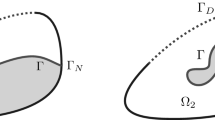Abstract
This work is concerned with inverse problems under the assumption that the contrast on the value of the relevant physical coefficient between the defect and the matrix is not very big. This is the so-called small amplitude, small contrast or small aspect ratio assumption. Then, following the idea developed by Allaire and Gutiérrez (in Math. Modell. Num. Anal. 2007) for optimal design problems, we make an asymptotic expansion up to second order with respect to the aspect ratio, which allows us to greatly simplify the inverse problem by seeing it as an optimal design problem. We are then able to derive a steepest descent optimization method to minimize the discrepancy between the given boundary measurement and that produced by solving the boundary value problem for a certain spatial distribution of the inclusion. Numerical results show that in the context of heat or electric conduction, the method is very efficient in terms of detecting the location of the inclusion and estimating its volume if it is located not too far from the boundary.
Similar content being viewed by others
References
Allaire G (2002). Shape Optimization by the Homogenization Method. Springer, Heidelberg
Allaire G and Gutiérrez S (2007). Optimal design in small amplitude homogenization. Math. Modell. Num. Anal. 41(3): 543–574
Allaire G, Jouve F and Maillot H (2004). Topology optimization for minimum stress design with the homogenization method. Struct. Multidiscip. Optim. 28(2–3): 87–98
Bendsøe M and Sigmund O. (2003). Topology Optimization. Theory, Methods and Applications. Springer, New York
Bonnet M and Constantinescu A (2005). Inverse problems in elasticity. Inv. Prob. 21(2): R1–R50
Burger M and Osher S (2005). A survey on level set methods for inverse problems and optimal design. Eur. J. Appl. Math. 16(2): 263–301
Gallego R and Rus G (2004). Identification of cracks and cavities using the topological sensitivity boundary integral equation. Comput. Mech. 33(2): 154–163
Guzina B and Bonnet M (2004). Topological derivative for the inverse scattering of elastic waves. Q. J. Mech. Appl. Math. 57(2): 161–179
Gérard P (1991). Microlocal defect measures. Comm. Partial Diff. Eqs. 16: 1761–1794
Hecht F. FreeFem++ Code and user manual freely available at http://www.freefem.org
Tartar L (1990). H-measures, a new approach for studying homogenisation, oscillations and concentration effects in partial differential equations. Proc. R Soc. Edinb. 115A: 193–230
Tartar L (1994) Remarks on optimal design problems. Calculus of variations, homogenization and continuum mechanics (Marseille, 1993), 279–296, Ser. Adv. Math. Appl. Sci., 18, World Scientific Publishing, River Edge
Trivailo PM, Dulikravich GS, Sgarioto D and Gilbert T (2006). Inverse problem of aircraft structural parameter estimation: application of neural networks. Inv. Prob. Sci. Eng. 14(4): 351–363
Author information
Authors and Affiliations
Corresponding author
Rights and permissions
About this article
Cite this article
Gutiérrez, S., Mura, J. Small amplitude homogenization applied to inverse problems. Comput Mech 41, 699–706 (2008). https://doi.org/10.1007/s00466-007-0225-3
Received:
Accepted:
Published:
Issue Date:
DOI: https://doi.org/10.1007/s00466-007-0225-3



